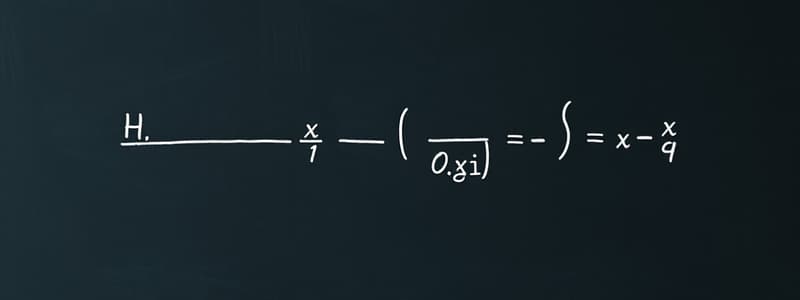Podcast
Questions and Answers
What is the nature of roots for the equation $x^2 - 3x - 10 = 0$?
What is the nature of roots for the equation $x^2 - 3x - 10 = 0$?
- No real roots
- Two distinct real roots (correct)
- Two complex roots
- One real root
Which pair of numbers has a sum of 27 and a product of 182?
Which pair of numbers has a sum of 27 and a product of 182?
- 11 and 16
- 9 and 18
- 7 and 20
- 10 and 17 (correct)
How many articles were produced if the cost of production of each article is twice the number of articles and the total cost is ₹90?
How many articles were produced if the cost of production of each article is twice the number of articles and the total cost is ₹90?
- 5 articles
- 15 articles
- 20 articles
- 10 articles (correct)
What are the two consecutive positive integers whose sum of squares equals 365?
What are the two consecutive positive integers whose sum of squares equals 365?
If the altitude of a right triangle is 7 cm less than its base and the hypotenuse is 13 cm, which equation represents this situation?
If the altitude of a right triangle is 7 cm less than its base and the hypotenuse is 13 cm, which equation represents this situation?
What is the value of the discriminant for the equation $3x^2 - 2x + \frac{1}{3} = 0$?
What is the value of the discriminant for the equation $3x^2 - 2x + \frac{1}{3} = 0$?
How many distinct real roots does the equation $3x^2 - 2x + \frac{1}{3} = 0$ have?
How many distinct real roots does the equation $3x^2 - 2x + \frac{1}{3} = 0$ have?
What are the roots of the equation $3x^2 - 2x + \frac{1}{3} = 0$?
What are the roots of the equation $3x^2 - 2x + \frac{1}{3} = 0$?
What values of $a$, $b$, and $c$ correspond to the quadratic equation $3x^2 - 2x + \frac{1}{3} = 0$?
What values of $a$, $b$, and $c$ correspond to the quadratic equation $3x^2 - 2x + \frac{1}{3} = 0$?
Why is the discriminant important in determining the nature of the roots of a quadratic equation?
Why is the discriminant important in determining the nature of the roots of a quadratic equation?
Flashcards are hidden until you start studying
Study Notes
Quadratic Equations and Discriminants
- Standard form of a quadratic equation: ( ax^2 + bx + c = 0 ), where ( a, b, c ) are real numbers, and ( a \neq 0 ).
- Discriminant formula: ( D = b^2 - 4ac ).
- Nature of roots based on discriminant:
- If ( D > 0 ): Two distinct real roots.
- If ( D = 0 ): Two equal real roots.
- If ( D < 0 ): No real roots; complex roots exist.
Example and Applications
- For the equation ( 3x^2 - 2x + \frac{1}{3} = 0 ):
- ( a = 3, b = -2, c = \frac{1}{3} ).
- Discriminant ( D = (-2)^2 - 4 \cdot 3 \cdot \frac{1}{3} = 0 ), indicating two equal real roots.
- Roots found: ( x = \frac{-b}{2a} = \frac{1}{3} ).
Factorization Method for Roots
- Example quadratic ( 2x^2 - 3x + 1 = 0 ):
- One root found by substitution: ( x = 1 ).
- Factorization leads to ( (2x - 1)(x - 1) = 0 ) yielding roots ( x = \frac{1}{2}, 1 ).
Solving Specific Quadratic Equations
- Roots of quadratic equations can be found through factorization:
- Example equations to factor:
- ( x^2 - 3x - 10 = 0 )
- ( 2x^2 + x - 6 = 0 )
- ( \sqrt{2}x^2 + 7x + 5\sqrt{2} = 0 )
- ( 2x^2 - x + \frac{1}{8} = 0 )
- ( 100x^2 - 20x + 1 = 0 )
- Example equations to factor:
Finding Roots Through the Quadratic Formula
- Roots can also be calculated using the formula:
- ( x = \frac{-b \pm \sqrt{D}}{2a} ) where ( D = b^2 - 4ac ).
Additional Problems
- Find two numbers whose sum is 27 and product is 182.
- Find consecutive positive integers such that the sum of their squares is 365.
- Determine sides of a right triangle where one side is shorter than the hypotenuse by 7 cm and hypotenuse is 13 cm.
- Solve for the number of items produced by a pottery industry given total production costs.
Key Takeaways
- Quadratic equations may possess a maximum of two roots, related to their factorization and polynomial behavior.
- Utilize the discriminant to assess the nature of roots quickly.
- Factorization is a valuable method to derive roots when applicable.
- The quadratic formula is a universal tool for finding roots.
Studying That Suits You
Use AI to generate personalized quizzes and flashcards to suit your learning preferences.



